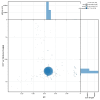The genome sequence of a soldier fly, Nemotelus pantherinus (Linnaeus, 1758)
- PMID: 40548330
- PMCID: PMC12181765
- DOI: 10.12688/wellcomeopenres.24309.1
The genome sequence of a soldier fly, Nemotelus pantherinus (Linnaeus, 1758)
Abstract
We present a genome assembly from a male specimen of Nemotelus pantherinus (soldierfly; Arthropoda; Insecta; Diptera; Stratiomyidae). The genome sequence has a total length of 804.69 megabases. Most of the assembly (95.93%) is scaffolded into 6 chromosomal pseudomolecules, including the X and Y sex chromosomes. The mitochondrial genome has also been assembled, with a length of 19.1 kilobases. Gene annotation of this assembly on Ensembl identified 27,389 protein-coding genes.
Keywords: Diptera; Nemotelus pantherinus; chromosomal; genome sequence; soldierfly.
Copyright: © 2025 Irwin A et al.
Conflict of interest statement
No competing interests were disclosed.
Figures





Similar articles
-
The genome sequence of the Broad Centurion soldierfly, Chloromyia formosa (Scopoli, 1763).Wellcome Open Res. 2025 May 23;10:266. doi: 10.12688/wellcomeopenres.24255.1. eCollection 2025. Wellcome Open Res. 2025. PMID: 40556666 Free PMC article.
-
The genome sequence of a phantom cranefly, Ptychoptera contaminata (Linnaeus, 1758).Wellcome Open Res. 2025 Jun 4;10:308. doi: 10.12688/wellcomeopenres.24276.1. eCollection 2025. Wellcome Open Res. 2025. PMID: 40823656 Free PMC article.
-
The genome sequence of the Asparagus Beetle, Crioceris asparagi (Linnaeus, 1758).Wellcome Open Res. 2025 Jan 15;10:18. doi: 10.12688/wellcomeopenres.23460.1. eCollection 2025. Wellcome Open Res. 2025. PMID: 40528997 Free PMC article.
-
The genome sequence of a long-legged fly, Argyra leucocephala (Meigen, 1824).Wellcome Open Res. 2025 Jun 4;10:309. doi: 10.12688/wellcomeopenres.24307.1. eCollection 2025. Wellcome Open Res. 2025. PMID: 40823658 Free PMC article.
-
The genome sequence of the lesser worm flesh fly, Sarcophaga ( Sarcophaga) subvicina Rohdendorf, 1937.Wellcome Open Res. 2024 Sep 4;8:65. doi: 10.12688/wellcomeopenres.18717.2. eCollection 2023. Wellcome Open Res. 2024. PMID: 37600583 Free PMC article.
References
-
- Bates A, Clayton-Lucey I, Howard C: Sanger Tree of Life HMW DNA fragmentation: diagenode Megaruptor ®3 for LI PacBio. protocols.io. 2023. 10.17504/protocols.io.81wgbxzq3lpk/v1 - DOI
-
- Beasley J, Uhl R, Forrest LL, et al. : DNA barcoding SOPs for the Darwin Tree of Life project. protocols.io. 2023; [Accessed 25 June 2024]. 10.17504/protocols.io.261ged91jv47/v1 - DOI
LinkOut - more resources
Full Text Sources

